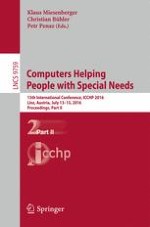2016 | OriginalPaper | Chapter
Types of Problems Elicited by Verbal Protocols for Blind and Sighted Participants
Authors : Andreas Savva, Helen Petrie, Christopher Power
Published in: Computers Helping People with Special Needs
Publisher: Springer International Publishing
Activate our intelligent search to find suitable subject content or patents.
Select sections of text to find matching patents with Artificial Intelligence. powered by
Select sections of text to find additional relevant content using AI-assisted search. powered by
